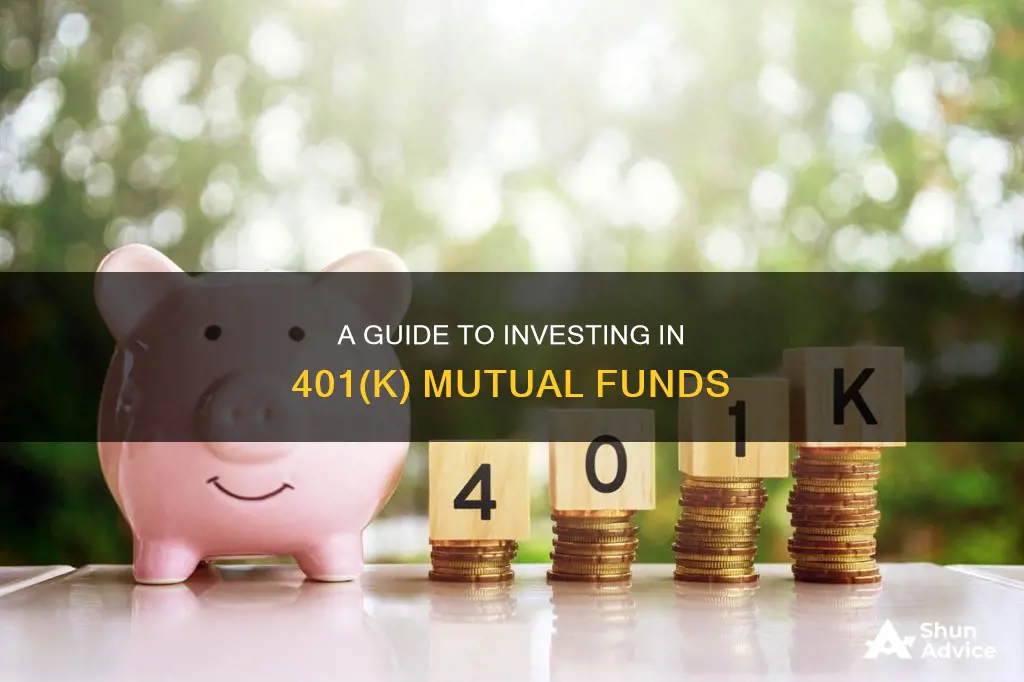
Mutual funds are a popular investment option, especially for retirement accounts like 401(k)s, as they offer a relatively hands-off way to invest in a diverse range of assets. When investing in mutual funds, it is essential to understand the different types of funds available, their associated fees, and how to choose the best funds for your portfolio.
1. Active vs Passive Funds: Decide between actively managed funds, where professionals aim to beat the market, and passive funds, which aim to mimic the market, often with lower fees.
2. Calculate Your Budget: Determine how much you can comfortably invest, considering the minimum investment amounts and potential fees.
3. Choose a Brokerage: You can buy mutual funds directly from fund companies, through an online brokerage, or with a financial advisor. Consider factors like affordability, fund choices, research tools, and ease of use.
4. Understand Mutual Fund Fees: Mutual funds charge an annual fee, expressed as an expense ratio. Passive funds tend to have lower expense ratios than actively managed funds.
5. Manage Your Portfolio: Rebalance your portfolio periodically to maintain your desired diversification. Avoid chasing short-term performance and stick to your investment plan.
Remember, investing in mutual funds offers instant diversification, and it is crucial to assess your risk tolerance, time horizon, and investment goals when selecting funds. Consult a financial advisor to help you navigate the different options and make informed decisions about your financial future.
| Characteristics | Values |
|---|---|
| Purpose | Retirement savings |
| Risk | Not investing is risky due to inflation |
| Returns | Historical average of 10% per year, but expected to be 4% over the next decade |
| Investment options | Stock funds, bond funds, target-date funds, stable value funds, individual stocks, bonds, ETFs, mutual funds |
| Investment strategy | Choose a target-date fund, or diversify your portfolio across asset classes and risk levels |
| Fees | Expense ratios vary by fund, but should ideally be below 1% |
| Contributions | Contribute as much as you can, ideally 10-15% of your income |
| Taxes | Pre-tax contributions lower your taxable income, Roth 401(k)s are taxed when contributed but not on withdrawal |
What You'll Learn
- Active vs passive funds: Choose between paying more for a fund managed by professionals or a more hands-off, lower-cost approach
- Investment budget: Consider how much you can invest, bearing in mind that mutual funds often have minimum investment amounts
- Where to buy: You can buy mutual funds directly from the company that created the fund, through an online brokerage, or with a financial advisor?
- Understand fees: Mutual funds charge an annual fee, expressed as a percentage of your investment
- Manage your portfolio: Consider rebalancing your portfolio annually to keep it in line with your diversification plan

Active vs passive funds: Choose between paying more for a fund managed by professionals or a more hands-off, lower-cost approach
When it comes to investing in mutual funds, there are two main approaches: active and passive investing. Each has its own advantages and disadvantages, and it's important to understand the differences before deciding which approach to choose.
Active investing involves a fund manager actively picking and choosing investments. This approach typically requires a hands-on and proactive strategy, with fund managers conducting extensive research and analysis to identify investments that can beat the market averages. Active investing can be more flexible, as fund managers are not required to hold specific stocks or bonds and can use various hedging strategies to insure against losses. It also allows for risk management, as fund managers can exit specific holdings or market sectors when risks become too large. Additionally, active investing offers the potential for higher returns, as fund managers aim to outperform the market. However, it tends to be more expensive due to the high fees associated with the extensive research and analysis conducted by fund managers.
On the other hand, passive investing typically involves tracking an existing group of investments called an index. This approach is often more hands-off and requires less buying and selling of investments. Passive investors usually buy and hold a basket of stocks, regardless of the market's performance, and focus on long-term gains rather than short-term fluctuations. Passive investing tends to have lower fees since there is no need for extensive research and analysis. It also offers good transparency, as investors know exactly which stocks or bonds are included in the index. Additionally, passive investing can be more tax-efficient due to the buy-and-hold strategy, which typically doesn't trigger large annual capital gains taxes. However, passive investing may be too limited, as investors are locked into specific holdings, and it may not provide the opportunity for significant returns.
When deciding between active and passive investing, it's essential to consider your financial goals, risk tolerance, time horizon, and the fees associated with each approach. Active investing may be more suitable for those seeking higher returns and willing to take on more risk, while passive investing could be preferred by those looking for a more hands-off approach with lower fees.
In terms of 401(k) plans, it's important to note that they typically offer a range of investment funds, including stock mutual funds, bond mutual funds, target-date mutual funds, and stable value funds. When choosing investments within a 401(k) plan, it's crucial to consider factors such as long-term returns, expense ratios, financial goals, risk tolerance, and time horizon. Additionally, diversification is key to minimizing risk and maximizing returns. While some 401(k) plans may offer the option to invest in individual stocks, bonds, or other mutual funds, it's generally recommended to diversify across different types of assets.
Short-Term Investment Strategies: Where to Invest Your Money
You may want to see also

Investment budget: Consider how much you can invest, bearing in mind that mutual funds often have minimum investment amounts
When investing in mutual funds, it's important to consider your investment budget and the minimum investment amounts that mutual funds often require. Mutual funds can be a great way to invest in a diversified portfolio of assets, but it's crucial to understand the costs involved.
Mutual funds typically have minimum investment requirements, which can range from as little as $100 to a few thousand dollars. Some funds may even have a $0 minimum, allowing you to invest in a mutual fund with a small amount of money. It's important to review the prospectus or offering documents of the mutual fund to understand the minimum investment amount and any associated fees or charges.
When deciding how much to invest in mutual funds, consider your financial situation, including your annual income, net worth, liquid assets, and tax status. Ensure you have enough liquid assets to cover your day-to-day living expenses, emergencies, and other financial obligations. It's also crucial to assess your risk tolerance, investment experience, time horizon, and investment objectives.
If you are investing for retirement through a 401(k) plan, it's generally recommended to contribute enough to qualify for your employer's match, if offered. This can provide tax benefits and help maximize your retirement savings. Additionally, consider your age and the number of years until retirement. Younger investors may be able to allocate a larger percentage of their portfolio to riskier stock funds, while older investors may want to shift towards more conservative investments.
When investing in mutual funds, it's important to diversify your portfolio and consider the fees associated with each fund. Expense ratios, management fees, and sales charges can impact your returns, so it's crucial to review the fund's prospectus or offering documents to understand all the costs involved. By considering your budget, the minimum investment amounts, and the fees associated with mutual funds, you can make more informed investment decisions.
Key Factors for Choosing the Right Mutual Fund Investments
You may want to see also

Where to buy: You can buy mutual funds directly from the company that created the fund, through an online brokerage, or with a financial advisor
There are three basic ways to purchase mutual funds:
Investment Companies
One option is to buy mutual funds directly from the investment companies that offer and manage them. These companies range from publicly traded giants like T. Rowe Price to private boutique firms like American Century or Dodge & Cox. Each firm offers a variety of funds designed to appeal to different investors and investment goals.
The key advantage of buying directly from mutual fund companies is that there are no sales commissions or brokerage fees, meaning more of your investment dollar goes directly into the fund. However, the downside is that your investment options are limited to that company's family of funds.
Investment-cum-financial services companies
If you want access to funds from multiple fund families, you can use an in-house account with investment-cum-financial services companies to buy and sell mutual funds and exchange-traded funds (ETFs) offered by other firms. Examples of such companies include The Vanguard Group and Fidelity Investments.
The catch with these companies is that they will naturally want to promote their own funds, so you may incur additional transaction fees or commissions if you choose funds from outside their family of funds.
Online Brokerage
Another option is to open an online account with a brokerage firm. This option will likely be the most expensive, as these accounts typically charge a transaction fee/commission for each trade and may also charge account setup or maintenance fees. However, they provide access to the largest selection of mutual funds.
There are many online brokerage firms to choose from, ranging from exclusively online companies like E*TRADE and Betterment, which tend to have lower fees due to reduced overhead, to traditional brick-and-mortar brokerages like Charles Schwab and Merrill Lynch, which have launched their own digital platforms.
Financial Advisor
Mutual funds are professionally managed investment vehicles that collect money from investors and invest it on their behalf. Mutual funds are ideal for investors who want to invest in securities but lack the necessary knowledge or time.
Financial advisors are licensed professionals who can help you choose the best mutual fund to invest in to meet your financial objectives. They will assess your current financial situation, risk tolerance, and investment goals to provide tailored advice and recommendations. Financial advisors also have a fiduciary duty to disclose all aspects of an investment to their clients in a morally and ethically right way.
When choosing a financial advisor, it is important to consider their knowledge, experience, and qualifications. Look for advisors who have experienced market fluctuations, hold relevant certifications or licenses, and have a comprehensive financial methodology.
KiwiSaver Investment Funds: Where Does Your Money Go?
You may want to see also

Understand fees: Mutual funds charge an annual fee, expressed as a percentage of your investment
When investing in mutual funds as part of your 401(k) plan, it is important to understand the fees involved. Mutual funds charge an annual fee, which is expressed as a percentage of your investment. These fees are important to consider as they can eat away at your returns over time, leaving you with less money for retirement.
Mutual funds are actively managed funds, meaning there are people behind the scenes picking investments for you. These funds contain different asset mixes, depending on the fund's strategy. Because of the human element involved, mutual funds tend to charge higher fees than other types of funds. The fees associated with mutual funds are known as expense ratios and are charged as a percentage of the amount invested. For example, if a fund has an expense ratio of 0.5%, you will be paying $5 for every $1,000 invested.
It is important to note that not all mutual funds charge the same fees. Some funds may have expense ratios that are well above the 1% mark. According to Morningstar, the average expense ratio for passive funds in 2018 was 0.15%, while for active funds, it was 0.67%. In recent years, mutual fund expense ratios have been trending downwards, which is beneficial for investors.
When considering which mutual funds to invest in as part of your 401(k) plan, it is crucial to compare the fees charged by different funds. Even small differences in fees can have a significant impact on your returns over time. For example, a fund with a 0.80% expense ratio could eat up $70,000 more of your returns over 30 years than a fund with a 0.40% expense ratio, assuming a 7% annual return.
To make a well-informed decision, you should also look at the fund's long-term returns over five- and ten-year periods, as well as its inception. This will help you assess whether the potential returns are worth the fees charged. Additionally, you can use resources like Morningstar to research each fund's fees, performance over time, and the companies and sectors that make up the fund.
While mutual funds can be a good option for investing in your 401(k), it is generally not advisable to put all your money into them due to their relatively high fees. Instead, consider diversifying your investments by including some index funds, which are passively managed and tend to have much lower fees. Index funds aim to match the performance of market benchmarks, such as the S&P 500, and do not have a fund manager actively picking assets. As a result, their expense ratios are typically lower than those of mutual funds.
By understanding the fees associated with mutual funds and considering alternative options, you can make more informed decisions about how to allocate your investments in your 401(k) plan to maximize your returns.
Strategic Investment: Maximizing Federal Funds for Long-term Growth
You may want to see also

Manage your portfolio: Consider rebalancing your portfolio annually to keep it in line with your diversification plan
When it comes to managing your portfolio, it is important to consider rebalancing it annually to maintain your desired level of diversification. This process involves buying and selling assets to realign your portfolio with your chosen asset allocation strategy, which balances the potential for high returns with your risk tolerance.
Monitor Your Portfolio's Performance
Keep track of how your portfolio is performing over time. This includes monitoring the asset allocation and identifying any deviations from your original plan. You can use tools like spreadsheets or investment monitoring software to help you stay on top of your portfolio's performance.
Set a Rebalancing Schedule
You can choose to rebalance your portfolio at regular intervals, such as once a year, or you can set tolerance thresholds for each asset class and rebalance when those thresholds are crossed. For example, you might decide to rebalance when an asset class deviates from its target allocation by 20%.
Consider the Tax Implications
When rebalancing, be mindful of the tax implications, especially if you are rebalancing a taxable brokerage account. Consider strategies such as tax-loss harvesting or using new cash contributions to minimize the impact of taxes on your rebalancing strategy.
Use Robo-Advisors for Help
If you feel overwhelmed by the process, consider using a robo-advisor. These are automated services that can help you rebalance your portfolio and provide other features like tax-loss harvesting. While they typically charge management fees, they can take the stress out of managing your investments.
Evaluate Your Goals and Risk Tolerance
As you rebalance, periodically evaluate your financial goals and risk tolerance. This will help you determine if you need to adjust your asset allocation strategy. For example, if you are nearing retirement, you may want to reduce your risk exposure and shift towards more conservative investments.
Focus on Your Main Accounts
If you have multiple investment accounts, prioritize rebalancing your main accounts, such as your 401(k) or IRA, as these will have the biggest impact on your overall financial health. However, don't neglect the role that smaller accounts play, especially if the holdings in those accounts are concentrated in specific areas.
American Funds: Which Investment Companies to Look For?
You may want to see also
Frequently asked questions
A 401(k) is a retirement investment account offered by your employer. It is a "tax-advantaged" investment account, meaning that the money you contribute to it each year, typically a percentage of each paycheck, lowers your taxable income.
Workers under 50 can contribute up to $19,500 to a 401(k) in 2020. However, how much you actually contribute depends on your income, debt level, and other financial goals. Financial experts advise contributing as much as you can, ideally between 10% and 15% of your income, especially when you are young.
All investing is risky, but keeping too much of your savings in cash can also be risky due to inflation. You need to determine an appropriate asset allocation, or how much of your investments will be in stocks (also known as equities) and how much will be in safer investments, like bonds. Stocks have the potential for greater returns but can be more volatile than bonds.
You'll need to do a bit of research before you make your selections. One way to assess each fund is to search its name on Morningstar, an investment research firm. On Morningstar's site, you'll be taken to a profile page for the fund, which will list its fees, performance over time, and what companies, sectors, stocks, and/or bonds make up the fund. You can also search the fund's name on Google to research its holdings, allocation, and more.
You can opt for a target-date fund, which takes most of the guesswork out of the equation. With these funds, you select a "target" retirement year and risk tolerance, and the fund automatically sets an appropriate asset allocation for you.
A 401(k) plan will typically offer a range of investments, but any single plan may not offer all types. The most common investment options include stock mutual funds, bond mutual funds, target-date mutual funds, and stable value funds.







